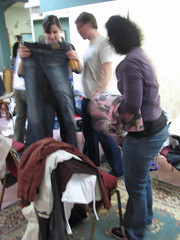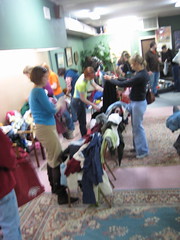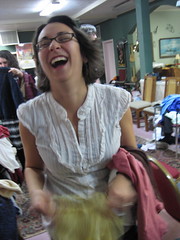So last week it seemed that I got in the thick of things over here at Sew Green. It was pollution-soaked jean extravaganza. Not that I’m opposed, really I’m not, but what the post really did seem to provoke was a whole lot of comments and a lot of email from people asking me the question that seemed a natural follow-up:
“Can you recommend a place to get these non-pesticide riddled clothing oh fabulous eco-fashionista?”
Ok, maybe it wasn’t quite like that. The important thing here is that you, the readers of sew green, need clothes that aren’t as harmful to the world. I can give you that information that you so justly deserve. So here for your pleasure is a list of places where you can buy organic/sustainable clothing, companies that make organic/sustainable clothing, and information for those of you who really don’t want to consume more out there but want to try your own hand at fashion.
The DIY set:
Since this is a blog that is also centering on consumerism I thought that I would start off with the DIY (or “D”o “I”t “Y”ourself) information first. If you don’t have clothing that you can refashion already then what you want to do is get thee to a Salvation Army (or goodwill etc)! Why I say these sorts of places rather than one of your cooler thrift locals? Because the cooler thrift stores are already selling “fashion.” If you’re going to cut up a suit jacket and make a corset top then you don’t need to fork over $60 for that 60s suit jacket. Trust me on this one. Do you and your wallet a favor.
So you have your jacket. Now what? Here is a VERY small list of some of the places I know about where you can make magic happen. Check it:
Live in San Francisco Area? Don’t have a sewing machine or know what the hell to do?
Stitch Lounge is the place for you. Run by “Two Melissas and a Hope” this great place not only teaches you basics but provides all the machines for you to do what you need to do! Serger? Check. Straight stitch machine? Check. Work tables, dress forms, notions and much more. Take a refashioning class if you don’t know where to begin or just go to their open studio times and have at it.
Live in NYC? Want to be craft? Step out to the
Make Workshop! They have everything a guy/girl to need to craft up a wardrobe! Classes, supplies and so much more… all in the heart of Manhattan! Bring a t-shirt to turn into a ball gown or a suit jacket to make into a mini-skirt. This is the place in the NY area to make it happen.
Attention Austin peeps!
First Samples is the place for you! Just like everyone else listed here they have a little something for the girl/guy who craves their own wardrobe their own way.
Love it but don’t feel like leaving your home? Then try some of these great books from the library!
“Sew U: The Built-by-Wendy Guide to Sewing Your Own Wardrobe” This is a book by NYC fashion darling Built-by-Wendy. On the whole I’m not a fan of her stuff BUT this book is great. You get three basic patterns and a whole lot of information. Great for intermediate sewers for sure.
“Generation T – 108 Ways to Transform a T-shirt” This book always seems to find new readers. They literally give you a 108 ways to make a T-shirt interesting and new. The bonus? Try taking these techniques and ideas into FITTED shirts. Then you start cooking with gas!
“Sew Subversive” By the aforementioned Stitch Lounge girls. The book is for beginners. There are some projects that can perk your brain into different directions but if you are into sewing and refashioning this might bore you.
Need support? There are PLENTY of people out there (like our dear Nikki) who are there for you:
Wardrobe RefashioningCONSUMER ALERT CONSUMER ALERT CONSUMER ALERT
Ok, so this is the part that I talk about some of my favorite manufacturer’s of sustainable and organic clothing. Again, this is just some of the places and people with whom I have given my hard earned greenbacks for their amazing goods. Yes these products are more expensive than their “conventional” brothers/sisters but I would rather refashion 500 t-shirts so I can save and by a top by one of these great designers.
Del Forte Denim (of course I’d start here!): Premium organic jeans for women. $125-$190 I wouldn’t be lying to say that these jeans are just the greatest. From shorts to skirts to jeans Del Forte has got it all. Made from seed to jean entirely in the USA – a rarity even in the premium denim marketplace.
Loomstate Denim: Premium organic jeans for men and women $125-$150 Indonesian Organic Cotton made in the USA. Their men’s jeans are where it’s at for sure. The jeans they make for women are really ill-fitting to say the least. Plus 90% of them are the (what I like to call) “Britney Spears” rise (aka 6”.) Ew. For men’s jeans though they can’t be beat for cut and wearability.
AC Clothing & Bags: Women's clothing $50-$200 Oakland, CA Amy Cools is cooler than ice. Her clothes are all hand made in her studio in Oakland's Temescal district. Made of recycled materials, vintage materials and vintage trims. From simple cute T's to fantastic multi-layered dresses and petticoats.
Passenger Pigeon : Women's clothing $76-$200 A great eco-clothing like from Canada. While they use a lot of bamboo and soy fabrics (not the best processes in the world) these are beautiful clothes that are easy and simple to wear. Playing with prints and textures this company walks a great line of fashion and sustainability.
Terra Plana Shoes are sassy and sustainable. $100-$150 Men and Women's Shoes. Made in the EU with sustainable materials. Not only are many of their styles organic but they go the extra mile to cut down or not use many of the harmful glues required in the manufacture of shoes. They are committed to the environment and have their eco policies plainly stated. I’ve got several pairs of their shoes and they wear great.
Stewart and Brown: Women’s clothing $55-$500 Organics, sustainable fabrics, factory surplus. Imported fabrics, Made in the USA. Stewart and Brown are the “organic pioneers” as they so humbly state on their website. But let’s face it – they were. Most of their line used to be a bit to “earthy crunchy” for me but they have begun to really get the fashion market as of late. Very pricey on their knits but oh so sexy.
Cydwoq: (pronounced sidewalk) shoes are little bits of leather art. Men’s and Women’s shoes $200-$300 (ow!) These are limited edition handcrafted shoes made in the USA Vegi-dyed leathers and water based glues. Way too pricey for this gal but I’ll tell you, if I could afford them – I would. They fit AMAZINGLY well and are so unique.
Enamore Lingerie Women’s lingerie $40-$125 What you expect to find in fine European undies. From bed-jackets to sexy bras this place has it all AND it is Eco. Hello nurse!
Junky Styling Refashioned clothing for the modern woman and man. $125-$500 I was blown away by these two women when I was in London. Takes refashioning from people's sewing rooms to the runway almost seamlessly (pardon the pun.) You can't tell that my sexy longsleeved wide necked shirt was once a track suit and a pair of men's pants. It's amazing. Best is that they can take your old vintage clothes and turn them into their latest runway clothing. Making thier clothes even more special to you. Top Notch.
So now a little love to the small boutiques in the bay area that (and NY) that sell eco fashion lines, but also some of the made in the USA smaller local designer types. After all, if you can't buy eco the next best thing is to buy local. Not only are you helping out the small shop owners you are benefiting the designers who sell there. Double bonus!
Doe: Lower Haight in San Francisco for Men, Women, Baby and Home. This place is just too great. Local made goods and amazing ones at that. Great for anyone in the bay area to find a "just right" gift for just about anyone. From beautiful vases to beautiful dresses this store's aesthetic is right on.
Gomi: Brooklyn, New York Women and Home This eco boutique is a powerhouse despite it's small size. For serious! The shop owner, Anne, picks out every piece herself (much like the above Doe - rock on Kati!) and the time it takes SHOWS. She has discerning taste and it's all eco and sustainable. Sexy and saving the planet. I heart GOMI (and it's not just because she sells our jeans.)
Relish at Home: Oakland, CA Men's & Women's (limited clothing) Home, Garden, Accessories This amazing little shop in Oakland pack a punch. This woman's shop is TINY (is this a trend?) and she packs it with some of the best independent designers this place offers.
This list is only the beginning. Please feel free to post YOUR favorite local businesses or sustainable clothing lines in the comments section. The more people who are out there making a demanding local and sustainable the more likely big companies will begin to "get it".



















